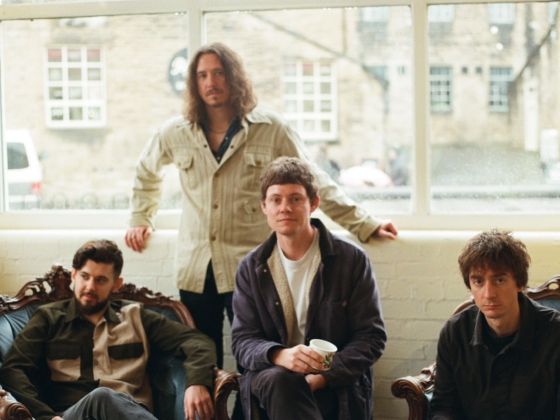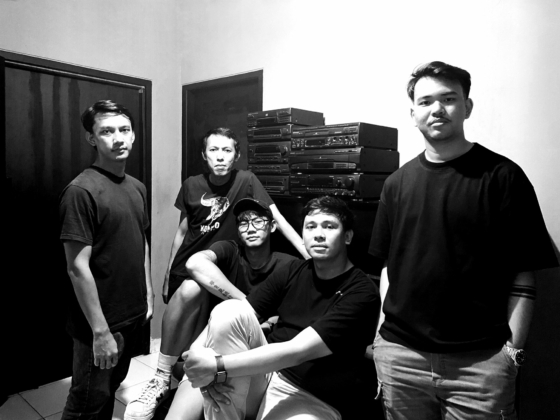“Down and out, so I'm out and down then looking for a substance to drown in.” Just one song into Kid Cudi’s career, he made it evident that he was struggling with demons and was self-medicating in perhaps not the most constructive way. This narrative would prove to be one that would follow him through the highs and lows of his career.
Over the course of his debut mixtape A Kid Named Cudi, Kid Cudi would explore his thoughts and emotions through simple melodic rap patterns. He wasn’t belting out any huge ballads at this point but was showing the signs of a matured artist who was questioning his mortality through his work while trying to find his place in the world. The self-described man on the moon showed his flaws through lyrics that erred on the side of overly self-aware. Kid Cudi uses the bridge on “Man on the Moon” to declare, “It's like, I'mma play all my stuff for everybody. And you know, and all my people they give me feedback. You know, and they'll be like, ‘Yo, yo, why your shit sound so different?’ You know what I'm saying? ‘Why your shit, like on another level—why's, why's it sound so different?’ Like that's a bad thing. And I be like ‘Why not? Nigga.’”
While he explored these emotions, the seasoned musician showed a glimpse of the various emotional battles that exist within him—making for a very dangerous emotional combination. While questioning his own mortality over production from Band of Horses’ “Funeral” he muses, “Sometimes I'm thinking God made me special here on purpose,” while singing about his own funeral—an emotional tragedy in its own right.
With this, we were introduced to the lonely stoner. Through weed and other drugs, Kid Cudi would medicate himself through isolation and depression, breeding these sufferings into a monster.
The dreams of the man on the moon.
A year after his debut mixtape, Kid Cudi shared his dreams with the world. Man On The Moon: End Of Day drew listeners into this world with an over-arching narrative that followed Kid Cudi through his dreams. Listeners were greeted to a futuristic, spacey atmosphere that blended psychedelic rock, pop, and electronic music.
The concept of the album was built around a lonely stoner’s dreams of success—with anxiety, night terrors, and drug abuse all being explored with the rise to fame. The line between dreams and what’s real soon becomes blurred and the listener has to decide whether we are still living in Kid Cudi’s dream, or if he’s living the dream.
The album didn’t add much texture to his plights, but instead hit the more deprived notes of depression; remaining simple in his basis and while touching on family, drugs, and alcohol, he never fully takes the leap into the deep end, leaving listeners doggy-paddling through his shallow expressions of very real emotions.
The simple expressions of deeply-complicated emotions resonated with a huge crowd and it wasn’t long before Kid Cudi shared the sequel to his debut in Man On The Moon series, The Legend Of Mr. Rager. Though not as interested in being a concept album, the album grew strength in colouring Cudi’s world in shades of green and purple. It played like a weekend bender—it had highs that included drugs and conviction, and the regrets and loneliness that accompany the morning after these highs.
The album would be less beloved by fans likely because Kid Cudi played wild and loose with the concept in this album, despite naming it a sequel to what many see as his magnum opus. One of the singles for the album also caused a huge divide in the fanbase. “Erase Me” once again reminded fans that Kid Cudi had interests that laid outside hip-hop. The song played like a grunge rock song from the 90s. And to the dismay of many fans, this would not be the last time Cudi entered the emo zone.
Leaving the moon.
Some critics believe that when Cudi left his 'Man On The Moon' series, he left behind the best years of his music career. The coming years were a time of experimentation for Cudi. Like many modern rappers, he took the time to learn how to take full control of his sound through production and experimentation. The result was inconsistent but a bold leap towards something less radio focused and more self-expressive.
Cudi formed an alternative rock group with the Dot Da Genius, known as WZRD. The self-titled debut album from the group disappointed fans and critics alike. Any fans of the rapper’s earlier work understood where the album came from, as many of his mixtapes featured production from bands like Vampire Weekend and The Kickdrums but only further exposed Cudi’s weaknesses—his singing and songwriting.
The Cleveland native assured his fans that a rap album was coming to satiate the rap listeners craving for spitting bars rather than his singing chops. The album would be completely self-produced, and the tone would be positive and confident. In fact, the album showed so much confidence that everything included in Indicud would be shown in a gold frame, including the album cover and music videos.
Kid Cudi shared that he had been working on his sobriety at this time in his life, which contributed to his first case of writer’s block while working on WZRD. Perhaps this developing internal struggle also contributed to his conflicts with peers.
A turbulent return to the moon.
After conflicts with once close friends—Lupe Fiasco and Kanye West—as well as new enemies Big Sean and Drake, it seemed like Kid Cudi was back to doing what he was good at: teasing a new Man On The Moon album.

At this time, it seemed Kid Cudi struggled between the idea of making the music he wanted and satisfying fans. He claimed he was releasing an EP as a prelude to Man On The Moon 3 and it would include a remix to his earlier hit single “Day N Nite”. However, listeners were instead surprised to get a 10-song record that felt more like a movie score than a traditional album, with sparse vocals isolated to just a few tracks. The few tracks that did include vocals painted a grim picture. Most notably with “Internal Bleeding” bearing the moan of a man who was on his last breath.
Kid Cudi’s struggles with drug addiction, depression, and suicide he’d battled throughout the years of fame became known to a wider audience as the general public’s perception of mental illness began progressing towards a place of greater acceptance and understanding. Quietly, he became an advocate for Didi Hirsch Mental Health Services, understanding that he’d made progress over the years, but wasn’t at a place of self-love yet.
Despite seemingly making progress by identifying his own triggers, the next few years proved to be some of the darkest for Kid Cudi. Speedin’ Bullet 2 Heaven had the Cleveland rapper return to his grunge rock form. The album almost felt like a strung-out ode to Kurt Cobain. It was a cluttered mess of rough demo cuts that were not only unique to Cudi’s catalogue but to music in general. It approached difficult topics in much deeper context. While feeling genuine in its angst and self-loathing, it left fans and critics disappointed with the effort.
Anyone following Cudi’s catalogue started to notice a pattern. It seemed he was beginning to actively exclude featuring guests or collaborations. This was off-character for someone who seemed to have his albums filled with friends and collaborators alike. And it wasn’t like he was pulling a J. Cole here; he wasn’t going platinum with no features with these efforts.
Finally, in 2016, everything culminated with Kid Cudi checking himself into rehab for depression and suicidal urges. The news would surprise no one, but marked just how far the man on the moon had fallen but there was still a shining star underneath that wasn't ready to go away.
Keep moving forward.
Despite the news Cudi had checked himself into rehab, it seemed he was actively trying to squash and turn around some of his bad habits. He announced a new album, Passion, Pain & Demon Slayin’ that featured long-time collaborators and friends alike. The album felt like a concerted effort against his illness, calling on friends and positivity not seen in his work for years. It was a gleeful expression of music without fear. Songs like “Surfin’” showed a guard-less artist who found nothing but energy in the bouncy drums and horns of the production. It felt like a return to form at times. And though Cudi may have worked on this album while he was at a personal low, it showed growth, maturity, and understanding of oneself.
It looked as if Cudi had realigned his trajectory and found what he needed with Passion, Pain & Demon Slayin’, so the main question was: what’s next? A third album in The Man On The Moon series was always on the mind of listeners thanks to years of rumours, but it was clear the man on the moon may not be the greatest iteration of Kid Cudi in terms of mental stability.
Perhaps understanding his depression’s relationship with the limelight, Cudi took some time off from music.
It wasn’t until 2018 that another artist known for struggling with mental illness would approach Kid Cudi about a collaboration that would send an electric shock through the music industry. Kid Cudi and Kanye West would collaborate as part of the “Wyoming Sessions” recorded in Jackson Hole. The collaboration would go on to be called KIDS SEE GHOSTS and feature both artists fulfilling their artistic potential.
KIDS SEE GHOSTS sees Kid Cudi painting a vivid picture of depression—more so than any of his past works, in much less air time. It was a piece of emotion that he had trouble articulating in other projects—perhaps because it was a celebration of the emotion, rather than an ultimatum. Past albums had been looking down the barrel of a gun or at the bottom of a pill box; KIDS SEE GHOSTS was shouted from the top of a mountain.
Kid Cudi uses the album to bridge his past to his future—and while doing so, captures every creative element he’s ever whiffed on.
I had my issues, ain't that much I could do
But, peace is something that starts with me, with me
At times, wonder my purpose
Easy then to feel worthless
But, peace is something that starts with me (with me, with me)
Had so much on my mind, I didn't know where to go
I've come a long way from them hauntin' me
Had me feelin' oh so low
Ain't no stoppin' you no way
All things, the night before
Ain't no stoppin' you no way
No stress yes, I'm so blessed and
I'm so, I'm so reborn, I'm movin' forward
In bars 3 to 6 above, Kid Cudi contrasts a sentiment he once held on "The Prayer". He's no longer assuming purpose is held with a greater force—he understands his purpose lies in his actions and that's how growth is achieved. Cudi's growth from his early mixtapes is palpable and shows a maturity that many hope to attain when it comes to their mental health.
This may be hard to hear for some, but I think the man on the moon will keep moving forward, onto the stars and there’s no way we’ll ever see him return to the moon. And we should celebrate that.
Didi Hirsch Mental Health Services provides free mental health, substance use disorder and suicide prevention services. For more information about Didi Hirsch’s services, please visit https://didihirsch.org/services/ or call Centralized Intake at 888-807-7250.









